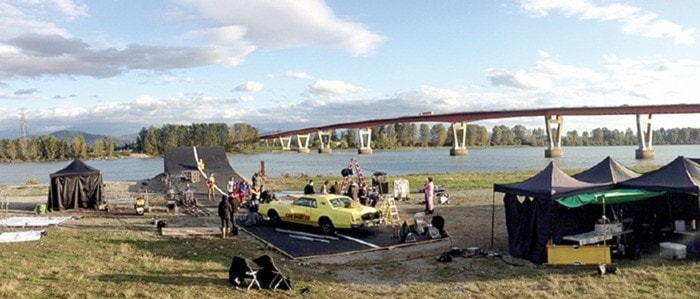Artificial lighting casts an odd, clean hue to the surrounding dense forest in Silverdale.
About 35 people are scurrying around a rundown home situated on 23 acres on Manzer Road, everyone busily flitting from group to group, giving and taking orders, or completing tasks.
Black power cables snake across the forest floor, wending between swordfern leaves, and climbing up and over fallen trees and hillocks, while a constant stream of vehicles shuttle staff from the Silverdale Hall parking lot to the film site.
Amidst all this organized, hurry-and-wait chaos, a movie is being filmed. Commands squawk out over the radios carried by crew members, calling for silence. Even those out of sight of the actual filming move as little as possible. The hushed tones and quiet movement ends as quickly as it started when “Cut!” emanates from the black Motorolas.
This is no longer a unique scene in Mission.
The Stave Falls Power House was transformed into a genetic research facility in X-Men 2 in 2003; Rocko’s Diner on Lougheed Highway was given a facelift for a Daniel Radcliffe movie last year; and a serial killer burned down a home on Moss Avenue in June, all while the cameras rolled.
With filming comes extra revenue for the District of Mission.
Stacey Crawford, Mission’s economic development officer, said an estimated $680,000 has been spent in Mission over the past two years. There were 34 days of filming in both 2012 and 2013. Crawford said a figure of $10,000 a day for indirect expenditures (fuel, lodging, food, construction materials, etc.) is used to estimate the local financial impact.
This number was provided by the International Film Commission and is used by municipalities such as Langley and Maple Ridge.

“It’s an area of opportunity for Mission. It creates new markets for local retailers and is generally a green industry,” he said.
One of the first Mission people movie industry representatives meet is film liaison Lesley White-Raymond, who works in the engineering department.
“It’s an exciting time,” said White-Raymond. “We’ve had some big films in the last few months.”
The most popular, she said, was Horns, starring Radcliffe of Harry Potter fame.
Other larger movies filmed here have been Signs of Destiny, Scarecrow, and a multitude of television commercials for companies such as A&W Restaurants and Opal cars.
Aim for the Roses is the most recent production in Mission. A large ramp was built on the banks of the Fraser River to replicate one of Canadian stuntman Ken Carter’s jumps. In 1976, Carter declared his intention to jump a mile over the St. Lawrence Seaway in a rocket powered car. Filming wrapped up last week.
There are some projects that escape the district’s notice as they shoot on private property, said White-Raymond.
However, the majority purchase business licences ($148 each), and filming permits ($250) which cover administrative costs associated with filming.
Since 2008, more than $55,000 has flowed into district coffers from permit fees.

White-Raymond said there’s likely even more money spent in Mission.
Once filming ends, each company is asked to send in a “wrap sheet,” which details the number of employees who were in Mission, what they spent and where. There is no obligation by the companies to return the sheets, so many, especially the smaller productions, fail to send them back.
Rico Mielnicki is a location manager who was recently filming in Mission, and has worked here a number of times.
“Mission has a few interesting areas,” he said, and many old houses located throughout the district, set into the hillside, which makes them very “San Francisco and Seattle-ish.”
First Avenue has a great small-town-U.S.A. vibe that makes it a popular spot to work, Mielnicki noted. “Mission has very interesting homes like you would find on Commercial Drive,” except costs are substantially lower.
Parking is always an issue, said Mielnicki, but there is ample space out here which removes one more item from the to-worry-about list. Renting land for parking in Mission is generally around $250 a day. In Vancouver, it can be as high as $5,000.
Mission residents also charge less for renting out their homes.
If someone is offered $1,000 a day to use their residence, they’re thankful, said Mielnicki. In Vancouver, it ranges up to $15,000 daily for some special, signature homes.
One of the drawbacks to coming to Mission is the distance, he said, “especially if you have to go back every day.”
Depending on the department, union rules dictate that employees must have at least nine to 11 hours off between shifts, which leads to shorter filming days.
Mielnicki was especially pleased with the film liaison, and said it makes coming to the district simpler.
His only critique was that she doesn’t work full-time.“I wish she had more hours. She’s very helpful when she gets here,” he said.
In the movie business, “we always want everything yesterday,” Mielnicki said laughing.
Permit revenue from films:
2013: $11,665
2012: $13,044
2011: $1,194
2010: $6,118
2009: $10,259
2008: $12,259
